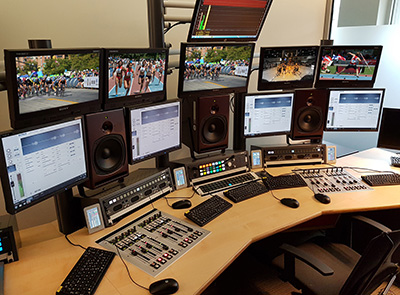The 25 years of Stage Tec’s product development have included users’ feedback and the inclusion of custom modifications to equipment. Recently, RTS (Radio Télévision Suisse) required a simple and automated workstation for the most common workflow in sports broadcasts – the 5.1 international audio mix of atmosphere from the sports event and the commentary from the booth.
 As a task for which typical sound control rooms are usually oversized in terms of equipment and manpower, RTS wanted a workstation that allows one sound engineer to operate four workflows in parallel, rather than occupying four control rooms and employing four audio engineers,.
As a task for which typical sound control rooms are usually oversized in terms of equipment and manpower, RTS wanted a workstation that allows one sound engineer to operate four workflows in parallel, rather than occupying four control rooms and employing four audio engineers,.
The challenge was that the international audio feed is very different in level for different sports, for example Formula 1 is much louder than tennis. Usually, the ducking in the mix is controlled with a fixed dim level, because it is only about one sport. However, if several sports are mixed in parallel, then this requires an intelligent ducking which takes each sport into account. This means an automated adjustment to the international audio level with the possibility of manual intervention, since the intention is to create a high-quality sound mix while ducking.
In cooperation with BFE, Stage Tec developed a stand-alone application with a connection to a television control room. The workstation is equipped with four On Air flex, two Nexus Base Devices, and four operator computers with RUI. The mixing consoles were given a structured user interface. Instead of a fader and monitor panel, two fader panels were mounted in one tray. Each On Air flex has four faders: two for the commentators, one for the international audio and the fourth to contros the pilot tone rather the level of an audio signal as is usually the case. This enables manual intervention during the commentary and the ducking attenuation of the international audio signal to be set.
‘With the small user-friendly On Air flex we can centralise the automatic mixing of four programmes in the same place by a single technician. For us, this is the strength of Nexus: centralisation and sharing of resources,’ says Yves-Alain Schneider, Head of Audio Production Sector at RTS. ‘The new DSP function, Multichannel Ducking, in which the ducking depth is controlled by the On Air flex fader, demonstrates the potential of the Nexus system. The workflow created here is suitable for all TV stations with sports programmes.’
More: www.stagetec.com














